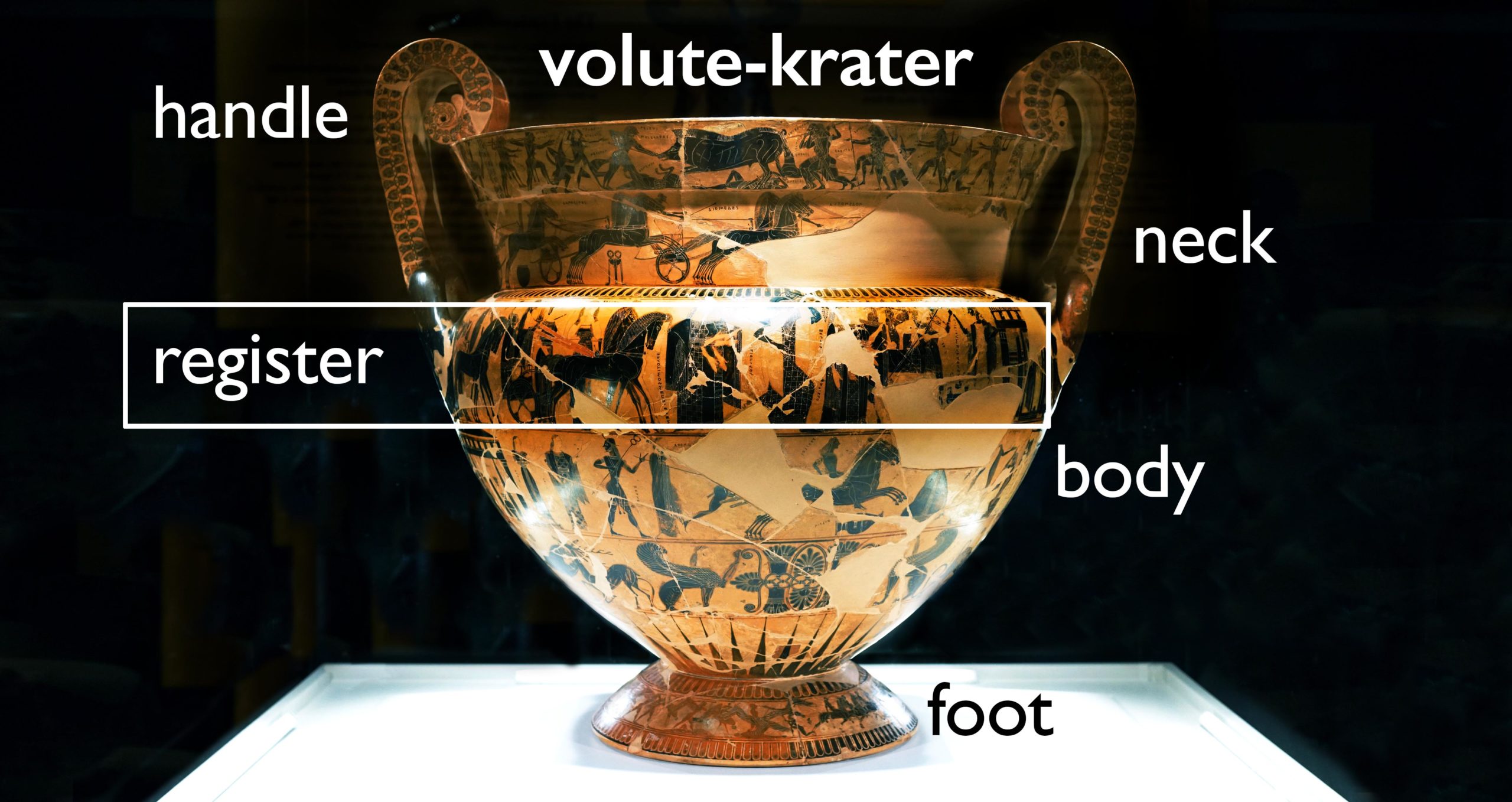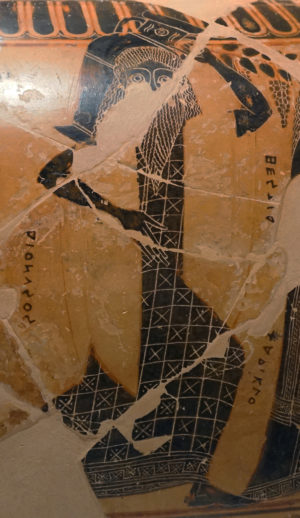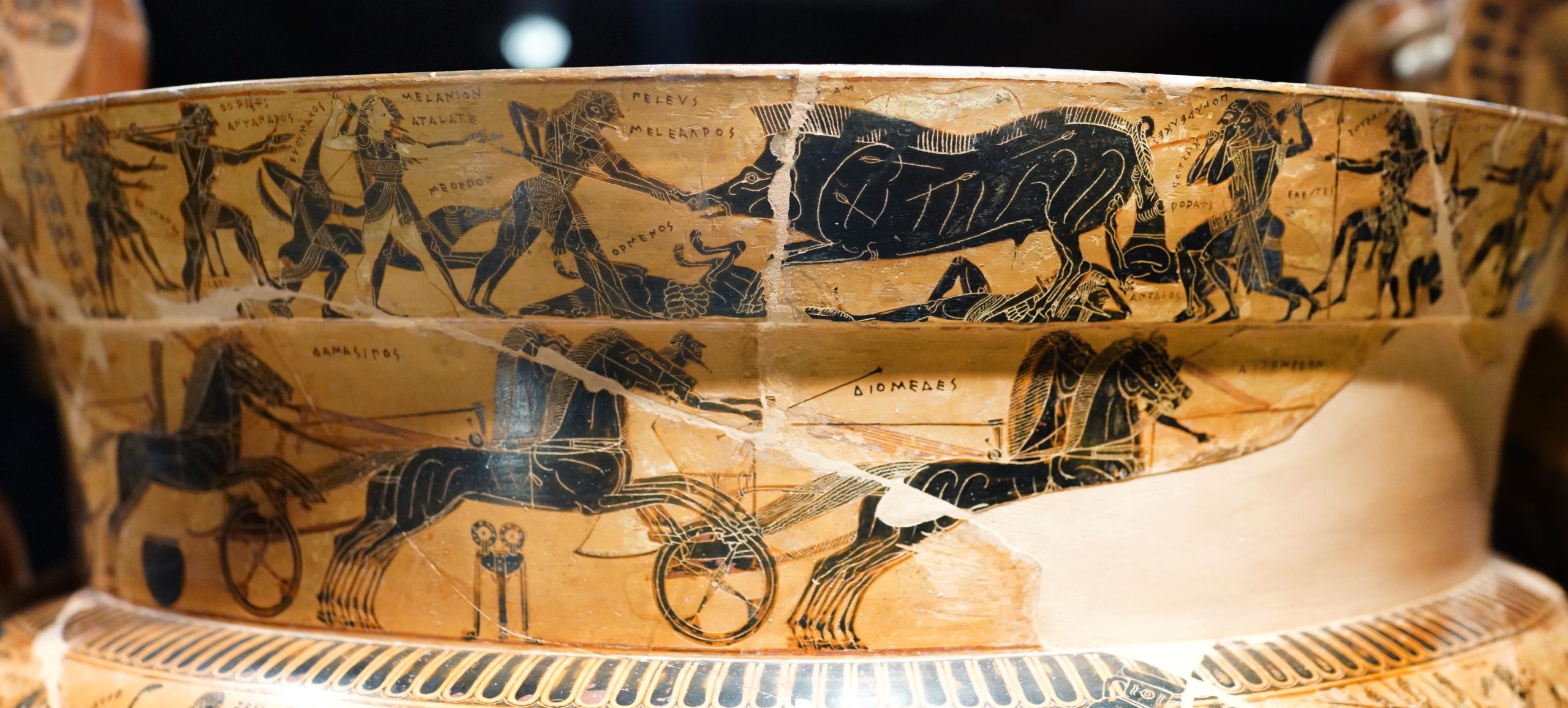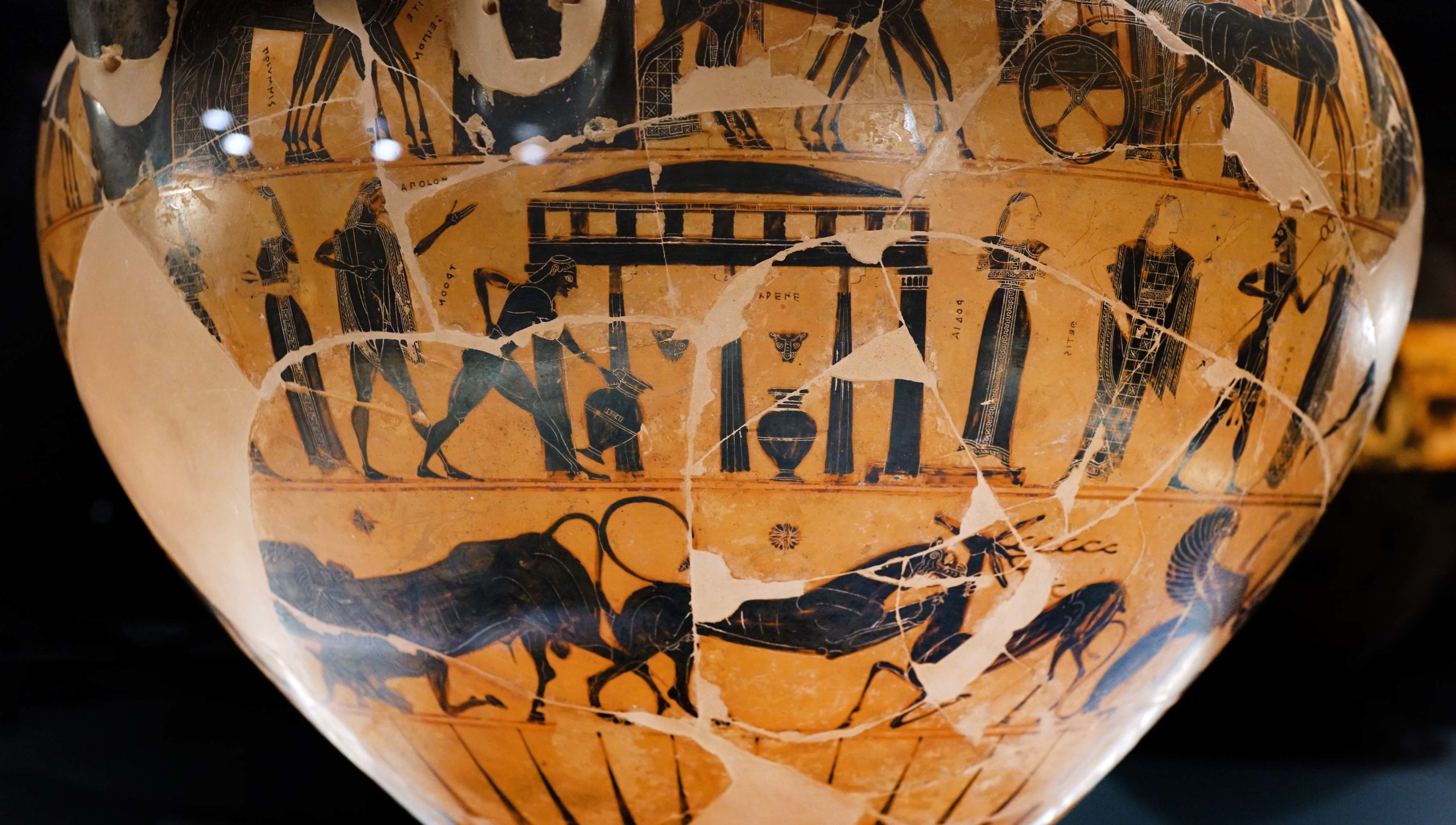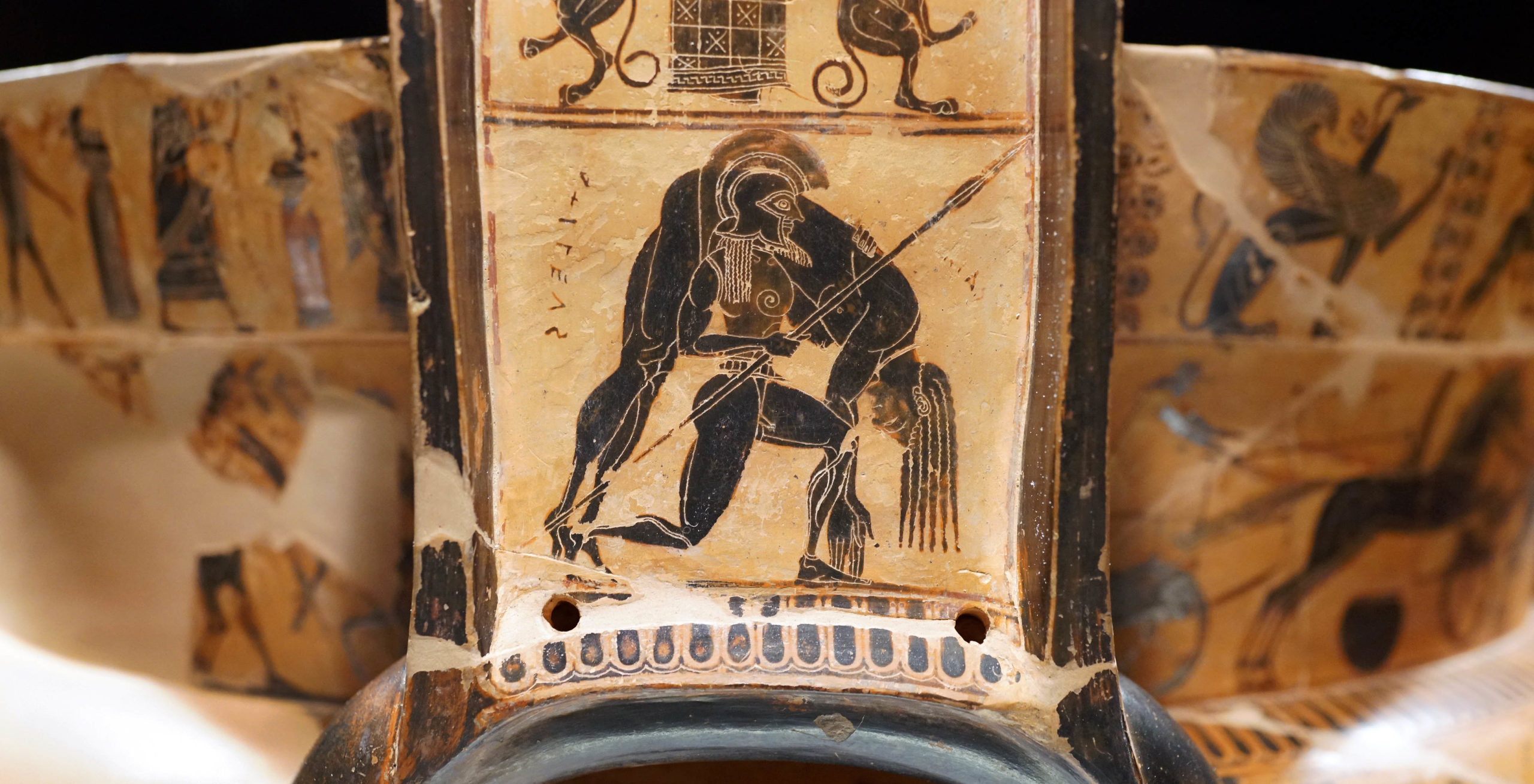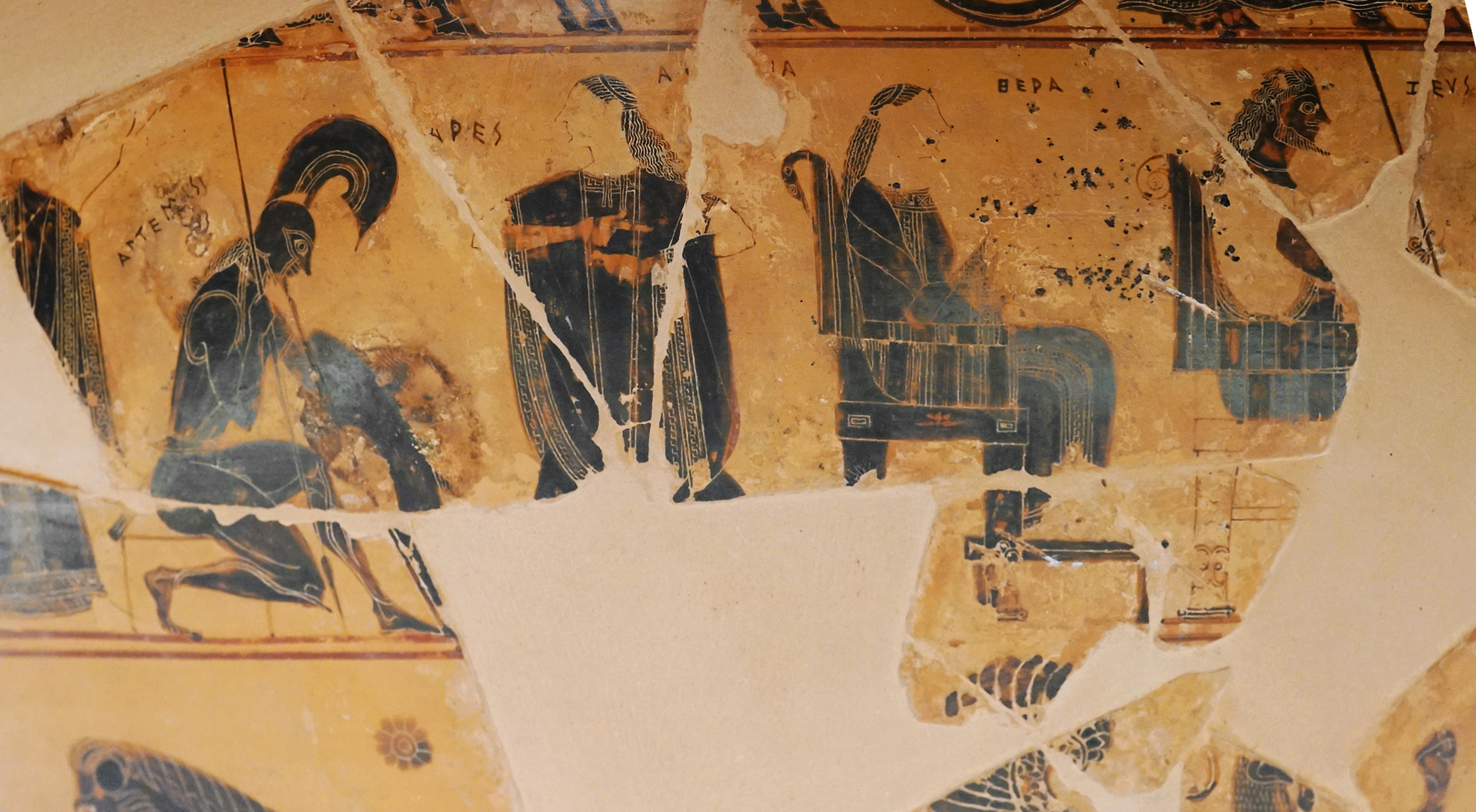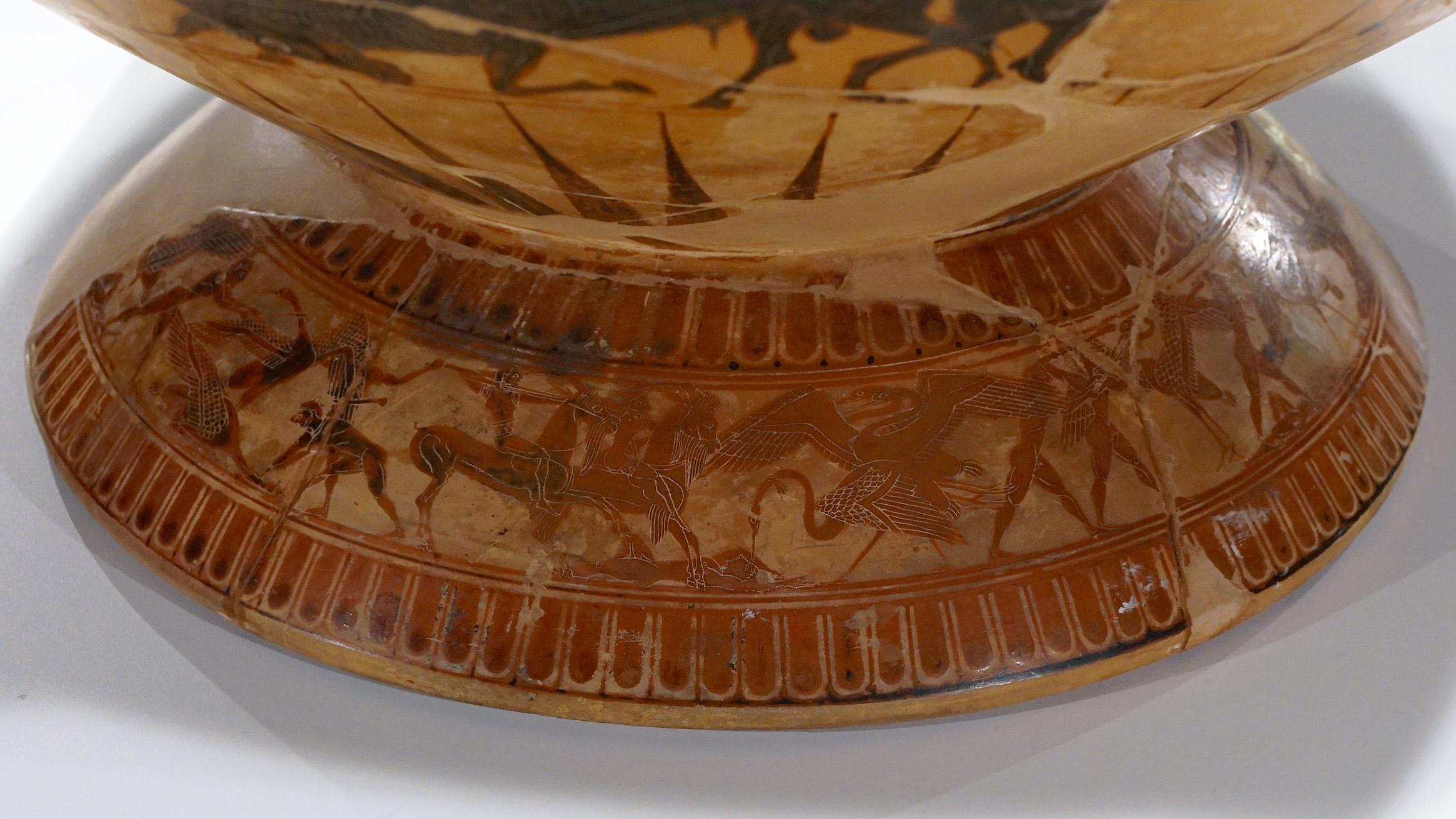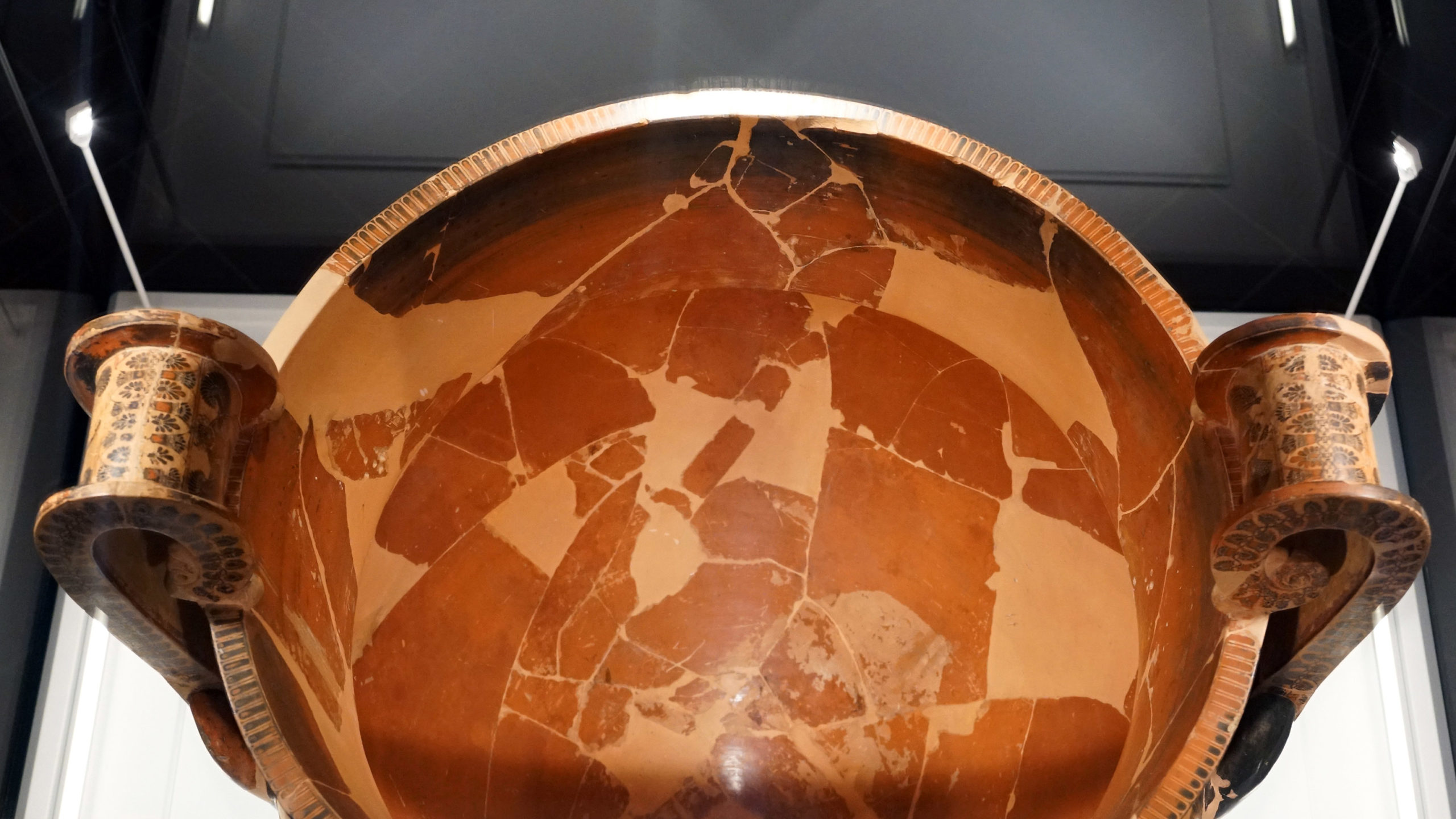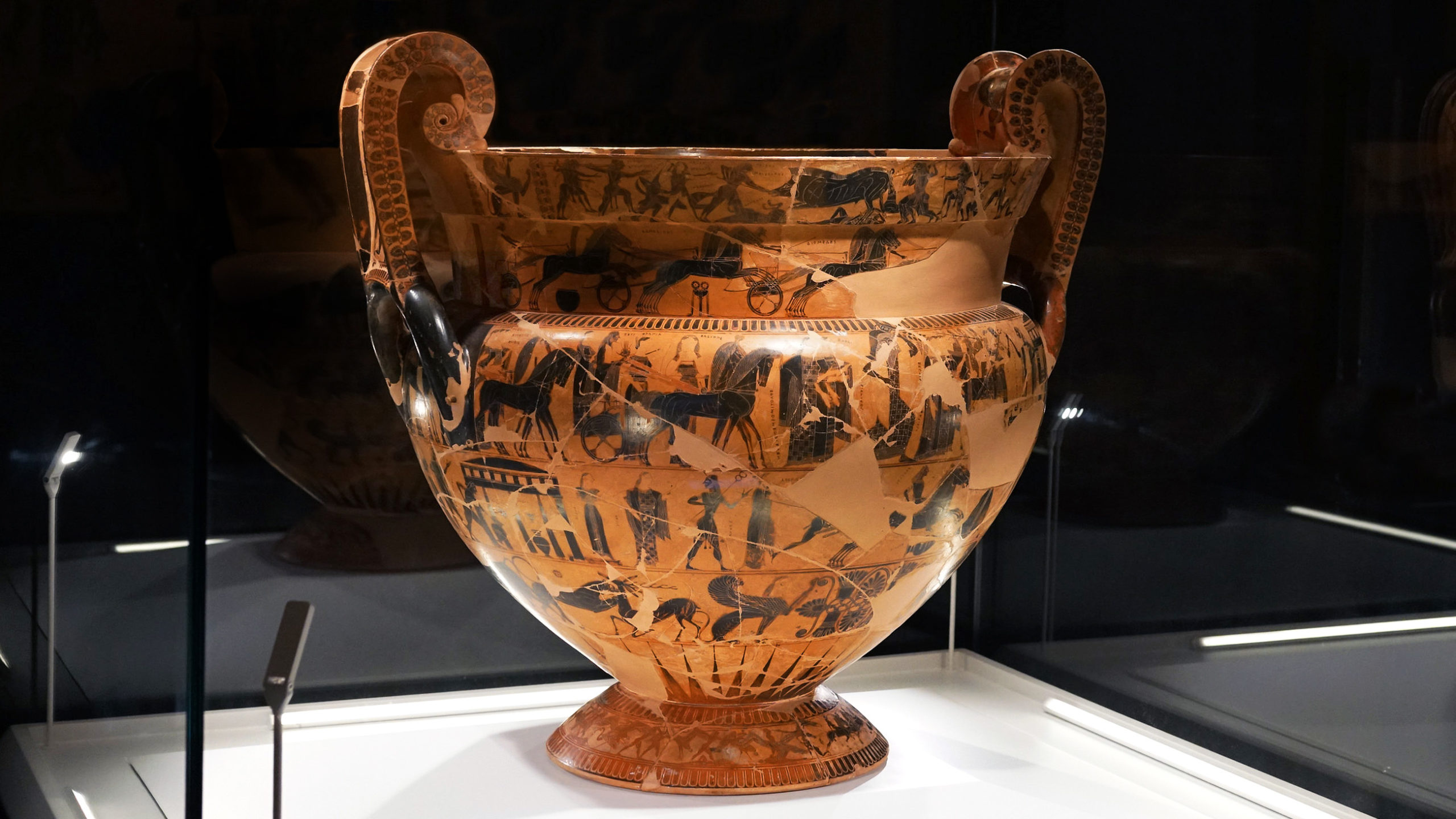
Kleitias (painter) and Ergotimos (potter), François Vase (volute-krater), mid-6th century B.C.E., Attic black-figure (made in Athens), 66 cm (Museo Archeologico, Florence)
A storybook
270 figures run, fight, and dance across the surface of the François Vase. While the decoration seems dense and busy to our modern eyes, an ancient viewer would have known all of these mythological stories from oral tradition and epic poetry and could identify each figure with the help of the 121 labels that accompany them. Let’s take a close look at scenes on the vase to better understand how it was used as a functional story book in the ancient world.
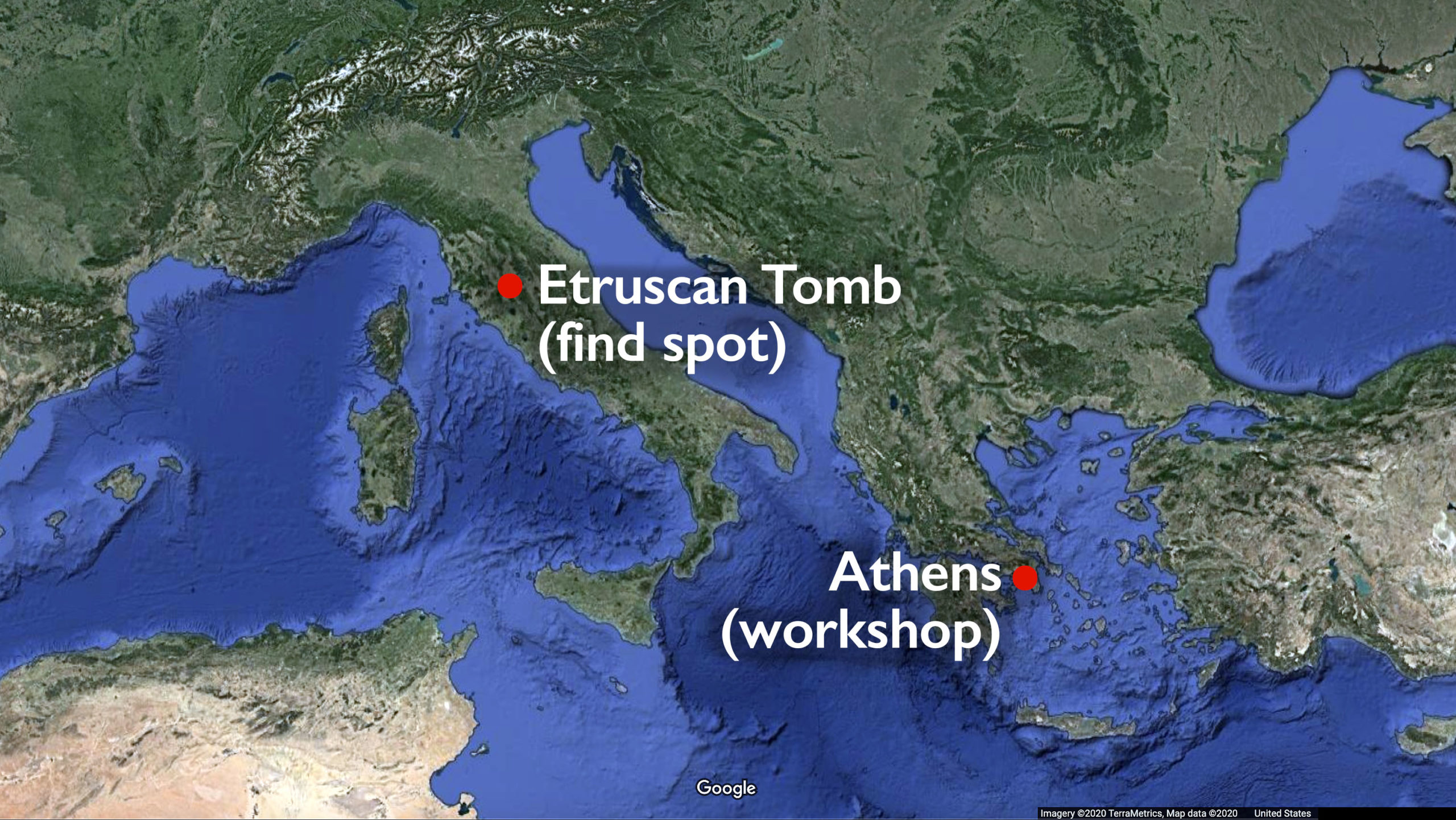
Alessandro François found fragments of the Francois vase in 1844 in an Etruscan tomb north of Chiusi, Italy. Subsequent excavations led to the discovery of additional fragments. The vase was made in Athens (Greece).
An Italian named Alessandro François found hundreds of fragments of the vase that now carries his name while excavating an ancient Etruscan tomb in Italy in the mid-1800s. Though found in Italy, the François Vase was made around 570 B.C.E. in Athens, Greece. In antiquity many Athenian vases were exported to Etruria, a region in Italy where consumers were eager to acquire Greek products.
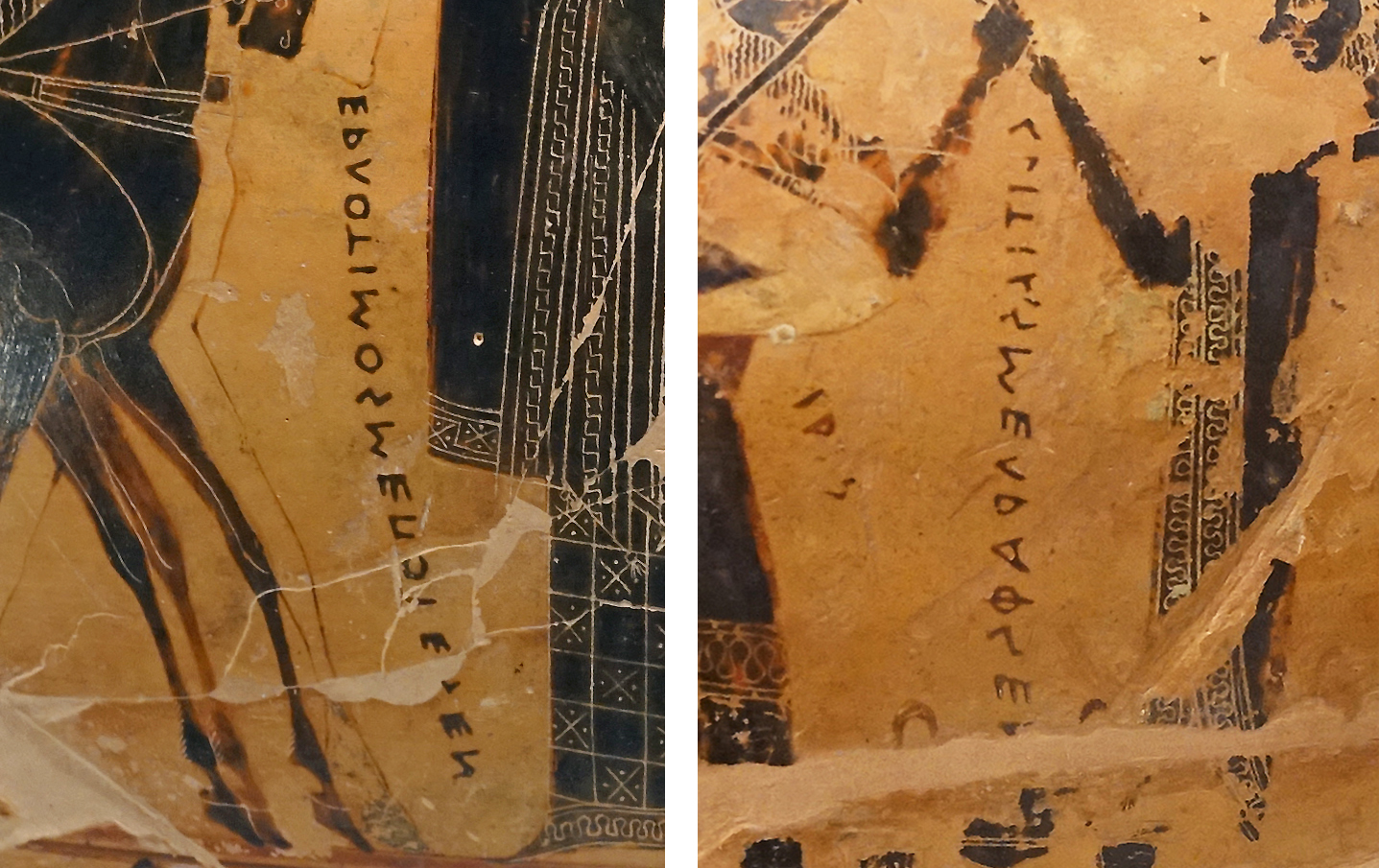
Detail with painted label (left) identifies Ergotimos as the potter; painted label (right) identifies Kleitias as the painter
Potter and painter
We know the names of the people who made the François Vase because they signed the vessel twice: Kleitias as painter, and Ergotimos as potter. This pair of artists collaborated on at least two other vessels that survive in fragments. The unconventional shape of the François Vase and its elaborate, well-planned decoration suggest that Kleitias and Ergotimos were an innovative team.
The François Vase is a volute krater (a vessel used for mixing water and wine with curling handles) and is likely one of the earliest vases of its type made in Athens.[1] The shape of its handles and its particularly large size create more space for painted decoration, which Kleitias, the painter, took advantage of. Kleitias used the black-figure painting style, which was popular among Athenian artists in the Archaic period. His work is dense but careful, and his attention to labelling figures and objects made his decoration even more legible to its original viewers. The neat labels of Greek text that accompany and identify many of the characters on the vase still help us understand its imagery today.
Heroes and gods
The François Vase is decorated in registers (horizontal bands of decoration sometimes referred to as a frieze). The main register appears at the center of the vase. It is the tallest register, and is one of only two, to show a single uninterrupted narrative around the vase’s entire circumference (the other is on the foot of the vase). This register shows the marriage of the hero Peleus to the nymph Thetis, a celebrated event attended by the Greek gods. This popular myth appears on several other vases painted in the early Archaic period, including a bowl made by Sophilos.
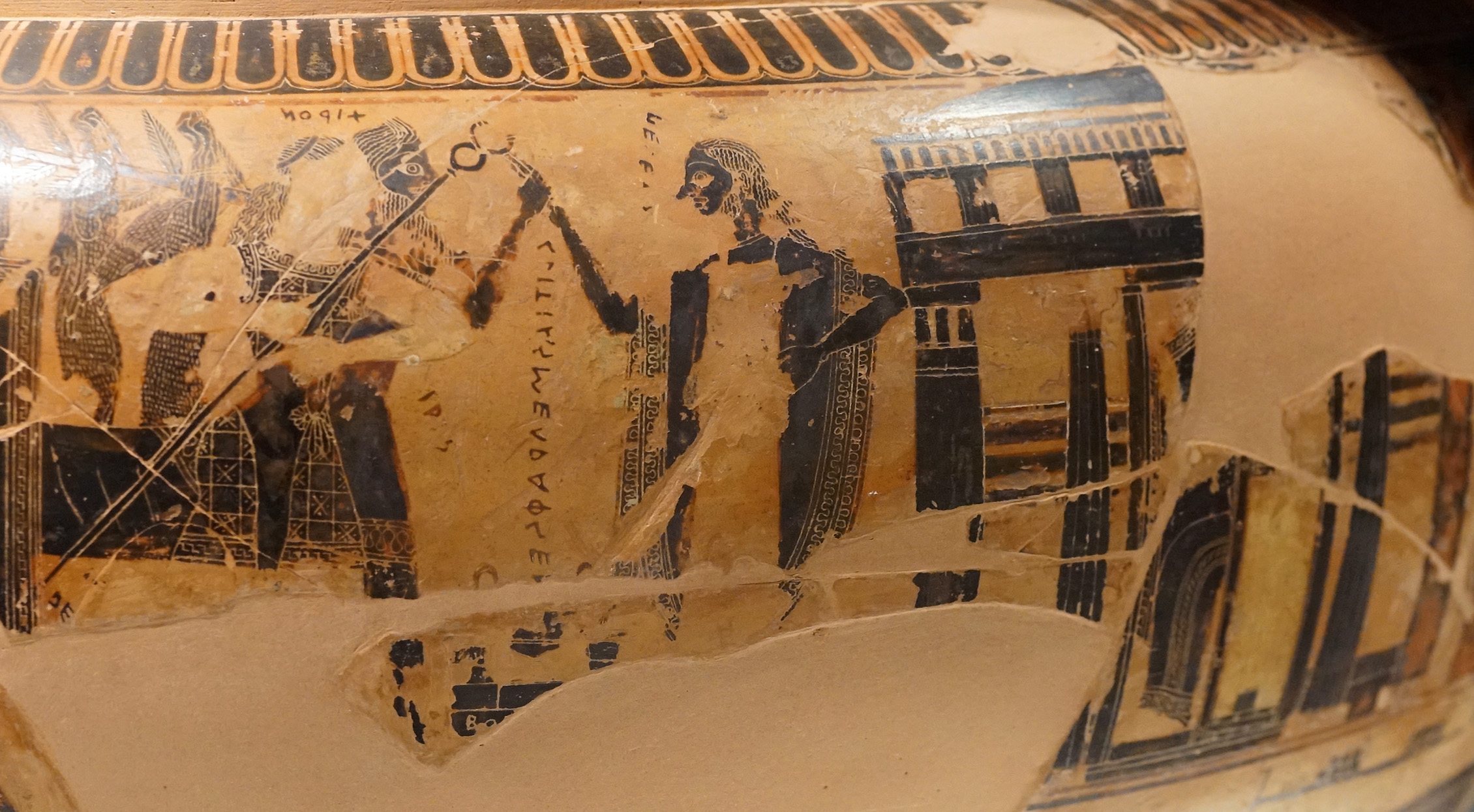
Detail with Peleus (center) who stands before his house greeting the centaur Chiron seen beside the goddess Iris (left) at the head of the wedding procession (the inscription identifying the painter can be read under their clasped hands). The seated Thetis (fragmented), can be seen within the house.
In this scene the wedding guests process towards Thetis, who sits in a grand house. Peleus stands outside of the house greeting a wise centaur (centaurs are half-man and half-horse) who will later mentor his and Thetis’s son, Achilles. The painter of the François Vase inserted himself into this central scene: beneath the clasped hands of Peleus and the centaur, a painted inscription reads ‘Klitiasmegraphsen,’ or ‘Kl[e]itias made me,’ as if the vase is declaring who painted it. The centaur is followed by female deities and Dionysos, god of wine, who carries an amphora (a jar for transporting wine). Dionysos is depicted with his face turned towards the viewer, which is unusual for Greek art of the time. In fact, Dionysos and Kalliope—a muse playing a wind instrument near Dionysos—are the only 2 human figures with frontal faces on the François Vase. More deities follow Dionysos on foot and in chariots, and the parade wraps around the vase.
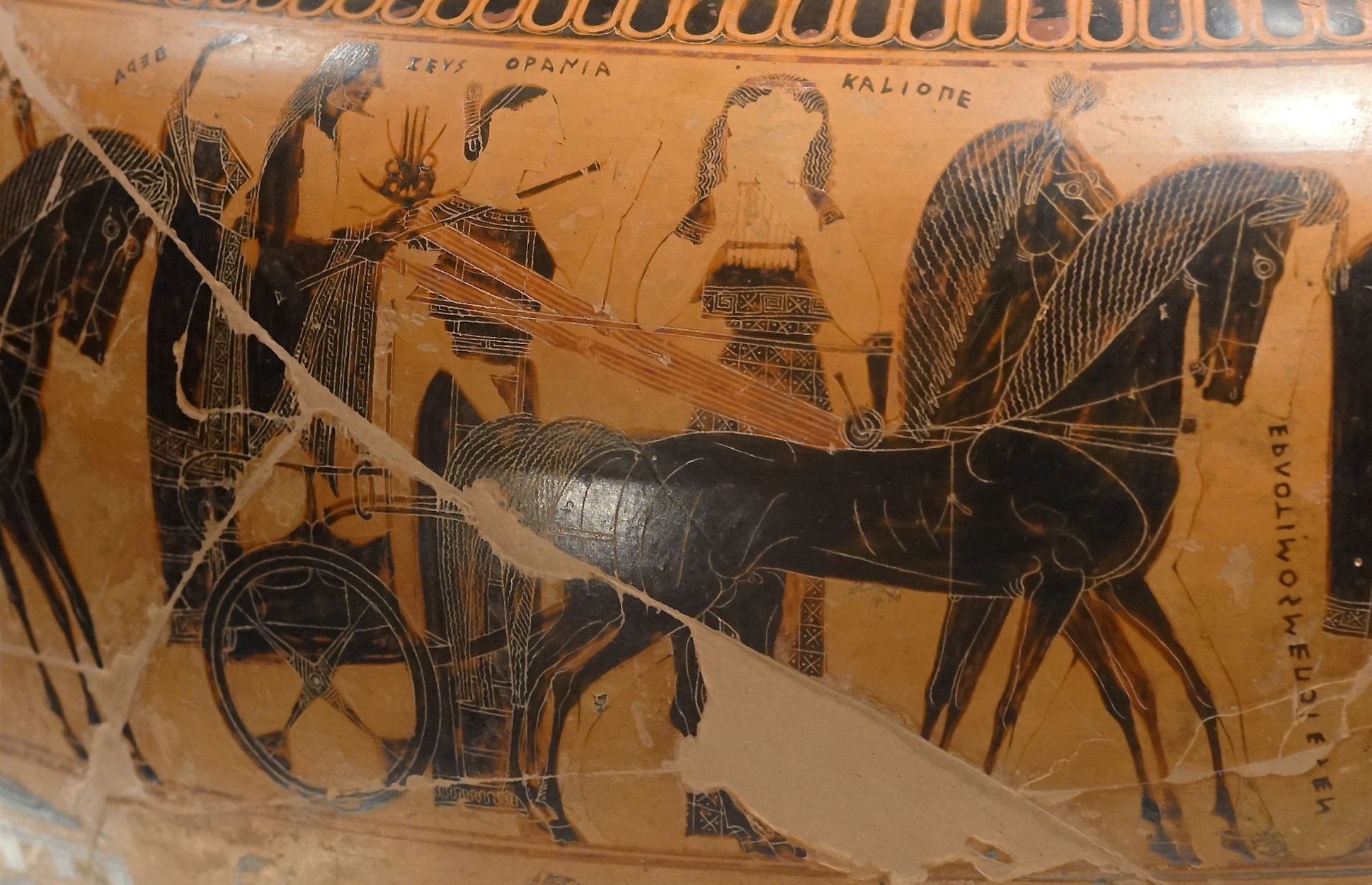
Detail with wedding procession with Hera and her husband Zeus in a chariot (left), Urania the muse of astronomy, and Kaliope, muse of epic poetry (center)
The registers on Side A (scholars refer to one side of the vessel as ‘Side A’ and the other as ‘Side B’ in order to easily differentiate between the two) of the François Vase depict a series of myths related to the hero Achilles and his father Peleus. The uppermost register shows Peleus hunting the Calydonian boar. The King of Calydon called upon the best hunters in the world to defeat the boar, whose strength is emphasized by the dead human and dog that lie beneath it. While many people aim spears, stones, and bows at the boar, Peleus and his companion attack it head on, ultimately defeating it.
The next register on Side A shows a chariot race organized by Achilles in honor of his closest friend who was killed in the Trojan War. This story is also told in Homer’s Iliad. A series of chariots strain to the finish line as Achilles stands beside the prizes he will award to the winner. The main register, showing the wedding of Peleus and Thetis, appears below the chariot race on Side A. It has a clear relationship to Achilles, as the marriage results in his birth.
The register beneath shows another episode from the Trojan War, in which Achilles killed the youngest son of the Trojan King while the boy was getting water outside the city walls. The fountain house at left sets the scene. At right, a messenger tells the King about the incident.
The end of Achilles’s life is shown on the handles of the François Vase. On each handle, beneath a goddess grasping a wild animal in each fist, we see the warrior Ajax carrying Achilles’ lifeless corpse. The tragedy of the hero’s death is dramatized: his body sags and his limp hair hangs down to the ground.
Side B of the François Vase has scenes that are not related to Achilles, but instead show an assortment of myths involving the Athenian hero Theseus and the gods. The top register shows Theseus playing a lyre as he leads 14 boys and girls in a dance. This may represent the the rescue, by Theseus, of Athenian children from the Minotaur, a monster who would have eaten them. Another pair of signatures by Kleitias and Ergotimos are partially preserved above a boat that seems to have carried the group to shore.
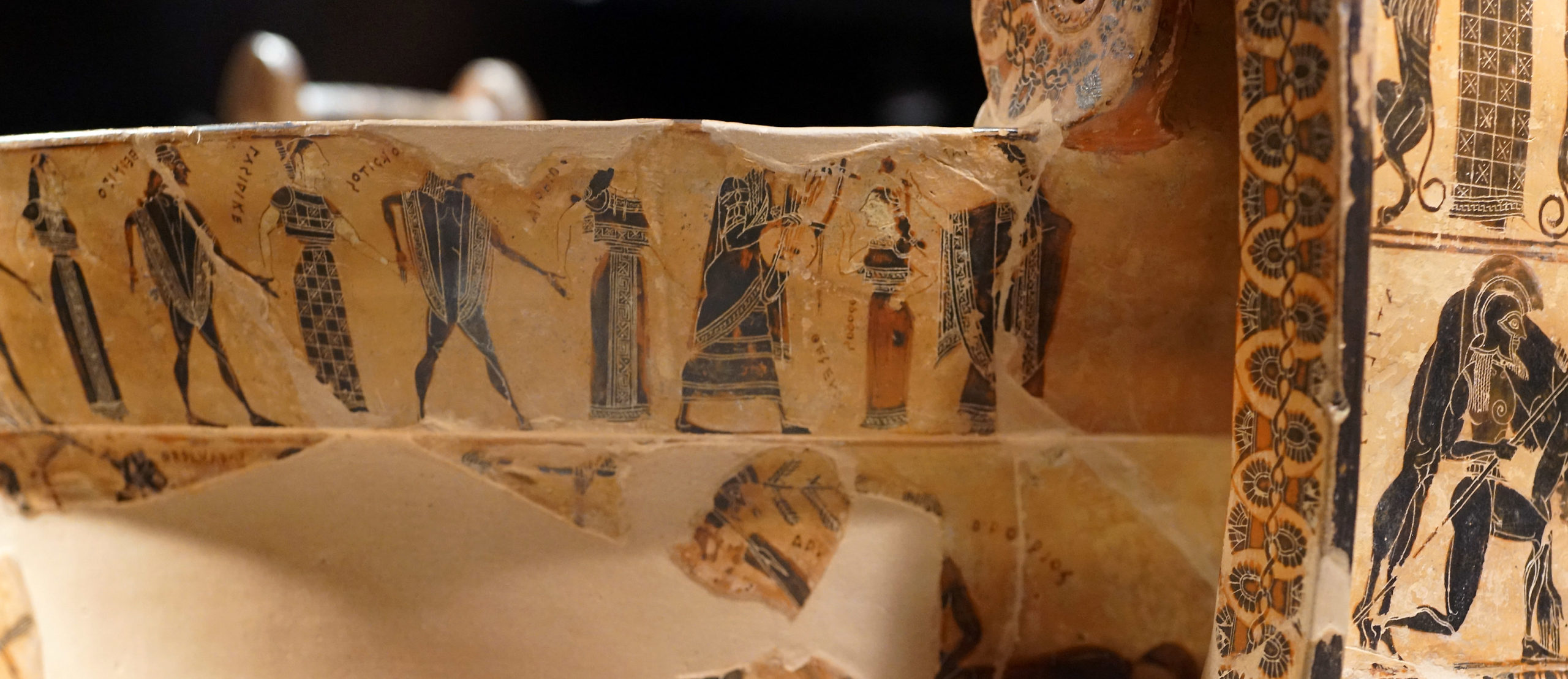
Detail with Theseus (center) playing a lyre at the head of a line of 14 dancing youths who he freed from the Minotaur’s labyrinth
Beneath the dance scene is a depiction of a battle between Greek men (including Theseus) and unruly centaurs at a wedding. Having drunk too much wine, the centaur guests began to attack women. The clashes between the groups are depicted as brutal and violent.
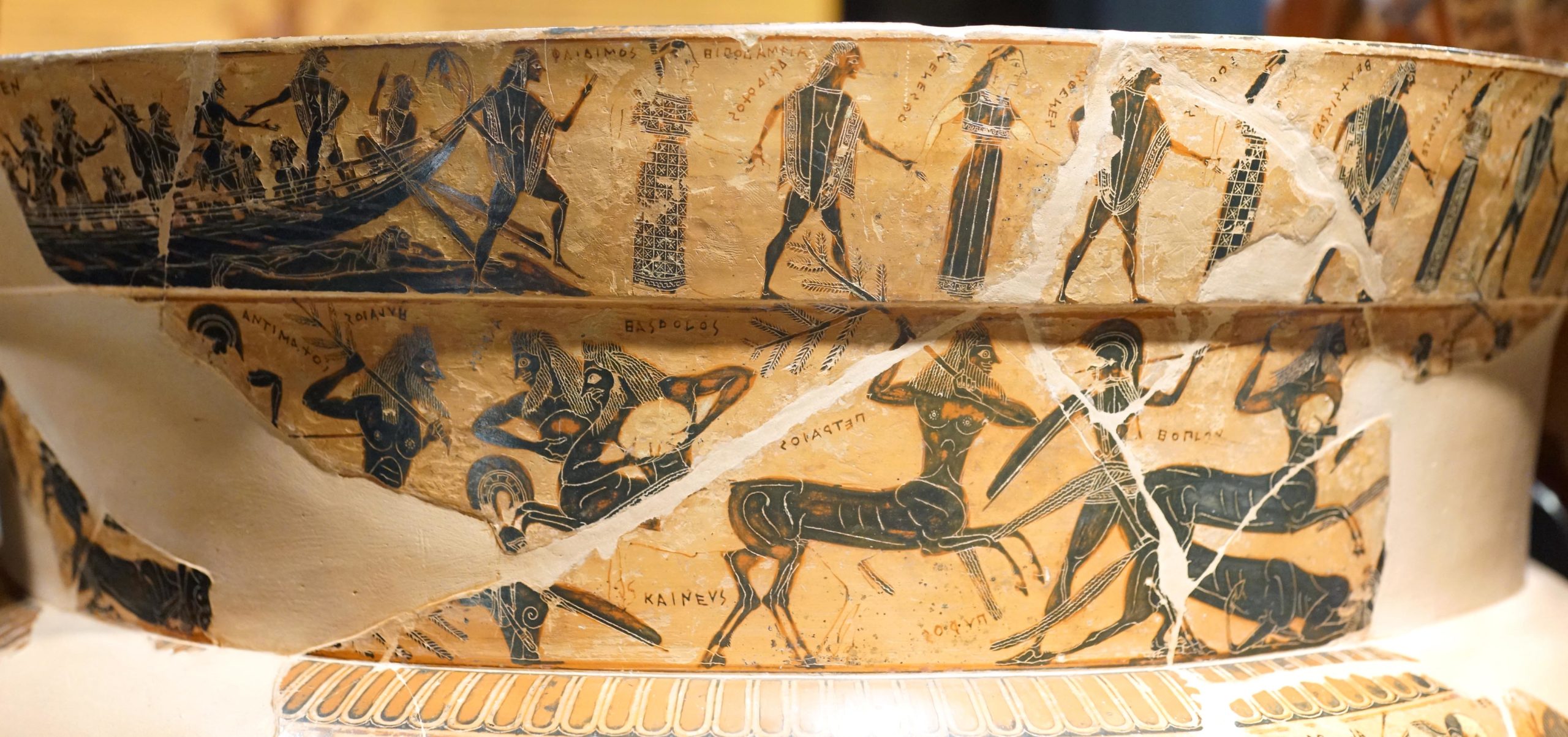
Detail with Athenian youth, freed from the Minotaur’s labyrinth by Theseus, disembarking from a boat; below the battle between the Lapiths and the centaurs
Finally, underneath the central register with Peleus and Thetis’s wedding at the bottom of Side B, there is an image of Hephaistos (god of smiths/craftsmen) returning to Mount Olympus (home of the Greek gods). According to Homer, Hephaistos was born with a bad foot, which Kleitias shows by painting the god’s feet pointing in opposite directions. Hephaistos was mistreated by his fellow gods and refused to return to Mount Olympus until Dionysos persuaded him by over-serving him wine. Once drunk, Hephaistos agreed to go home, and was carried back on a donkey. Here, the relatively positive effects of drinking are shown, in contrast with the negative effects experienced by centaurs at the wedding depicted above.
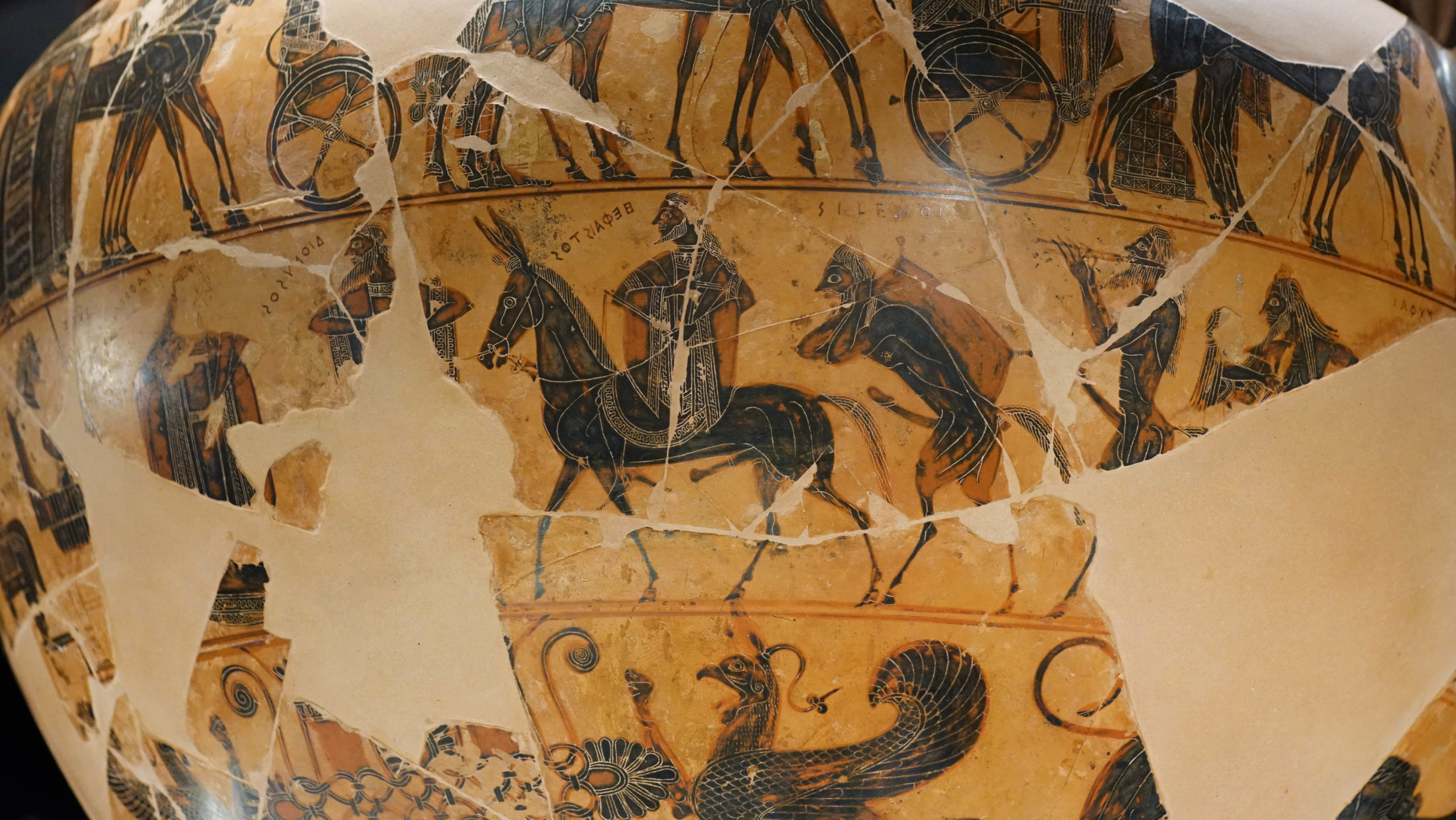
Detail with the return of Hephaistos to Mount Olympus, with Dionysos ahead, and the satyr Silenus behind
To the left of Hephaistos and Dionysos, the painter Kleitias represents the gods and goddesses of Mount Olympus including Hera. Hephaistos was angered by the cruelty of his mother Hera, and sent her a beautifully crafted chair. When she sat in it, the chair entrapped her. Here we see Hera awaiting her son’s return so that he can release her.
In addition to these narrative scenes, another register at the bottom of the vase shows animals fighting. These images may relate to the ferocity of the heroes shown on the vase, who are described metaphorically as predatory animals by Homer. A comic scene of pygmies (a tribe of small people in Greek mythology) battling cranes decorates the foot of the vase, providing a light counterpoint to the rest of the imagery. The paint on the foot is reddish in color instead of black because the vase was misfired in the kiln, as sometimes happened in ancient Greek ceramic production.
Function and meaning
How was the François Vase used, and by whom? Kraters were used for mixing wine with water at a symposium (a drinking party for upper class men). Since ancient Greeks only drank wine diluted with water, kraters were crucial to the symposium, and were set up in the middle of the room where partygoers drank. The interior of the François Vase has scratches which may have been made by a utensil mixing the wine, but it is unclear whether the vase was used at symposia in Greece, in Etruria (Italy), or in both places.[2] It may have been used at lavish parties in Athens, or in a funerary banquet honoring the deceased in Etruria before it was buried as a grave offering.
Wealthy, educated individuals attending banquets in either place would have recognized the scenes shown on the vase, and might have used them as conversation starters. Other vessels used at symposia in the Archaic period were also commonly painted with mythological scenes and could have served a similar purpose, but the sheer number of scenes on the François Vase may have made it particularly intriguing to the banqueters who used it. They may have even understood the images to be relevant to their own lives. While the pictures had different meanings for different viewers, the scenes of drinking on the François Vase mirror the circumstances in which it was actually used. Moreover, many of the scenes on the vessel represent ideal aristocratic activities that the drinkers likely participated in, including noble marriage, successful hunts, and military combat.
Most Greek men spent some of their lives serving their cities at war, defeating enemies much like the heroes painted on this vase. Like Peleus, Greek men were expected to marry and raise their children to be productive citizens. It seems that Kleitias and Ergotimos purposefully designed the decoration to appeal to the prosperous owners of the vase, who could recognize and relate to the stories it told.[3]
Postscript
On September 9, 1900 a museum guard, in a fit of rage, threw a chair at the case containing the François Vase, shattering it into 638 pieces. The museum director, Luigi Milani asked Pietro Zei to undertake the conservation of the François Vase. Conservation took two years.[4]
Footnotes
[1] Jasper Gaunt, Ergotimos Epoiesen: The Potter’s Contribution to the François Vase,” in The François Vase: New Perspectives, ed. H. Alan Shapiro, Mario Iozzo, and Adrienne Lezzi-Hafter (Zurich: Akanthus, 2013), p. 81
[2] Mario Iozzo, “The François Vase: Notes on Technical Aspects and Functions,” in The François Vase: New Perspectives, ed. H. Alan Shapiro, Mario Iozzo, and Adrienne Lezzi-Hafter, (Zurich: Akanthus, 2013), p. 61
[3] Cornelia Isler-Kerenyi, “Der Francois-Krater zwischen Athen und Chiusi,” in Athenian Potters and Painters: The Conference Proceedings, ed. John H. Oakley, William D. E. Coulson, and Olga Palagia, (Oxford: Oxbow, 1997), p. 523–539
[4] “9/9/1900: il vaso François e il “sacrilego custode,” blog post, National Archaeological Museum of Florence, September 9, 2013 <https://museoarcheologiconazionaledifirenze.wordpress.com/2013/09/09/991900-il-vaso-francois-e-il-sacrilego-custode/>
Additional Resources
This pot at the Museo Archeologico, Florence
Read more about Greek vase-painting
Guy Hedreen, “Bild, Mythos, and Ritual: Choral Dance in Theseus’s Cretan Adventure on the François Vase,” Hesperia, vol. 80, no. 3 (2011), p. 491–510.
Mario Iozzo, The François Vase: Rex Vasorum, King of Vases (Florence: Edizioni Polistampa, 2018).
Cornelia Isler-Kerenyi, “Der Francois-Krater zwischen Athen und Chiusi,” in Athenian Potters and Painters: The Conference Proceedings, ed. John H. Oakley, William D. E. Coulson, and Olga Palagia, (Oxford: Oxbow, 1997), p. 523–539.
H. Alan Shapiro, Mario Iozzo, and Adrienne Lezzi-Hafter, eds., The François Vase: New Perspectives (Zurich: Akanthus, 2013).
Rudolf Wachter, “The Inscriptions on the François Vase,” Museum Helveticum, 48, pp. 86–113.
Smarthistory images for teaching and learning:
[flickr_tags user_id=”82032880@N00″ tags=”francoispot,”]

